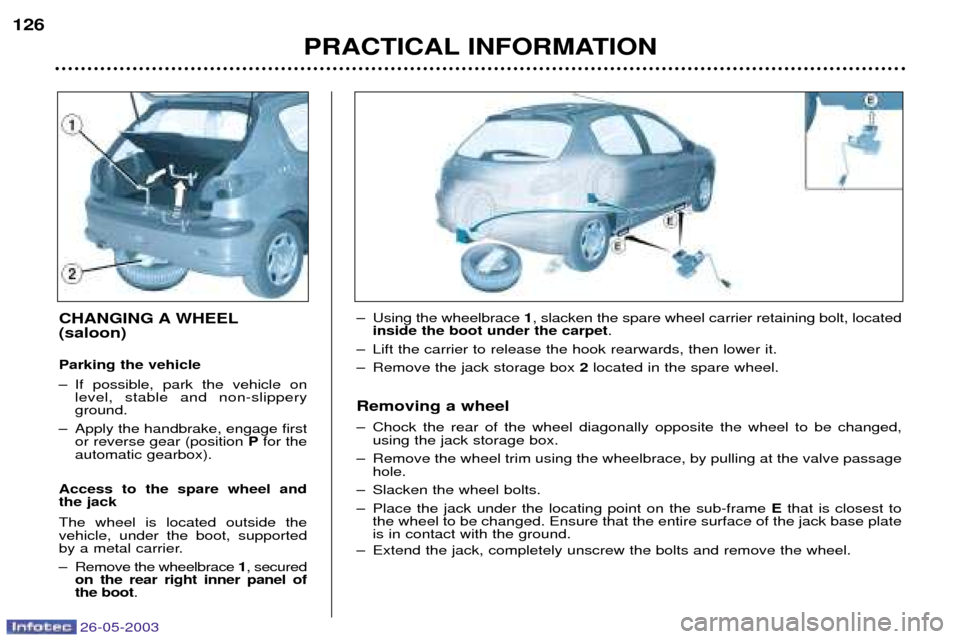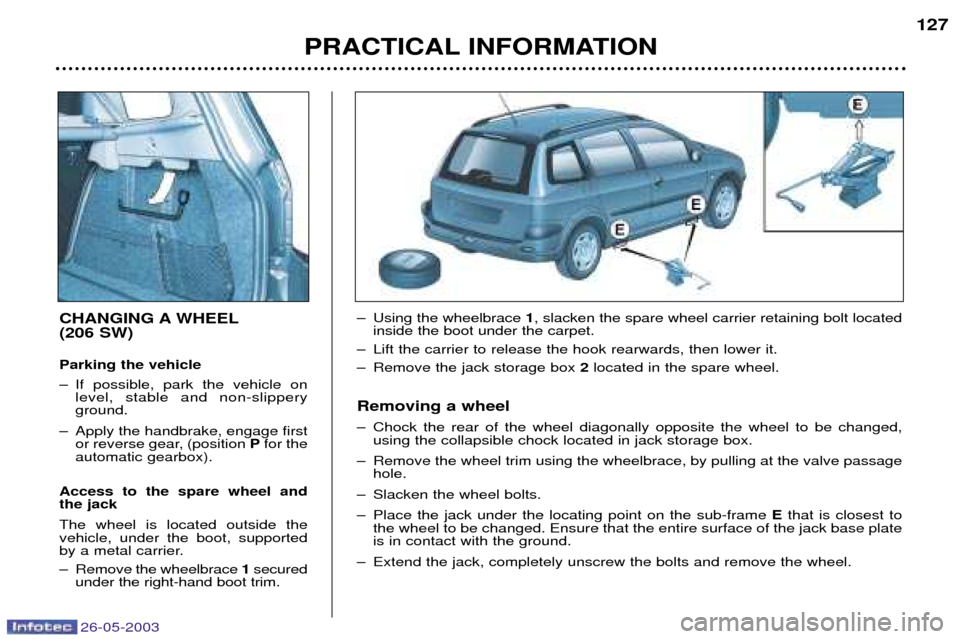Page 132 of 168

26-05-2003
PRACTICAL INFORMATION125
CHECKS Battery
At the start of winter, have your bat-
tery checked by a PEUGEOT deal-
er. Air filter and passenger compartment filter Have the filter elements replaced regu-
larly. If you drive in dusty conditions,
change them twice as often .
Brake pads Brake pad wear depends on the style of driving, in particular for vehi-cles which are used in town, overshort distances. It may be necessary to check the thickness of the pads, even betweenservices. Handbrake Where the handbrake travel is too great or there is a reduction in theperformance of the system, thehandbrake should be adjusted, evenbetween services. Have the system checked by a
PEUGEOT dealer. Manual gearbox This does not need an oil change. Check the level, according to themanufacturer's servicing schedule. Automatic gearbox This does not need an oil change. Have the level checked by a
PEUGEOT dealer, according to themanufacturer's servicing schedule. Oil filter
Change the filter regularly, in accor- dance with the servicing schedule.
Only use products recom-
mended by PEUGEOT.
To ensure best perfor- mance from compo-
nents as important as the powersteering and the braking system,PEUGEOT selects and offersquite specific products.
RUNNING OUT OF FUEL (DIESEL) If you should run out of fuel, it is neces- sary to re-prime the circuit: 1.4 litre HDI engine
Ð fill the fuel tank with at least five litres of diesel,
Ð operate the manual re-priming pump, until fuel appears in the transparent pipe under the bonnet,
Ð operate the starter until the engine starts.
Page 133 of 168

26-05-2003
PRACTICAL INFORMATION125
CHECKS Battery
At the start of winter, have your bat-
tery checked by a PEUGEOT deal-
er. Air filter and passenger compartment filter Have the filter elements replaced regu-
larly. If you drive in dusty conditions,
change them twice as often .
Brake pads Brake pad wear depends on the style of driving, in particular for vehi-cles which are used in town, overshort distances. It may be necessary to check the thickness of the pads, even betweenservices. Handbrake Where the handbrake travel is too great or there is a reduction in theperformance of the system, thehandbrake should be adjusted, evenbetween services. Have the system checked by a
PEUGEOT dealer. Manual gearbox This does not need an oil change. Check the level, according to themanufacturer's servicing schedule. Automatic gearbox This does not need an oil change. Have the level checked by a
PEUGEOT dealer, according to themanufacturer's servicing schedule. Oil filter
Change the filter regularly, in accor- dance with the servicing schedule.
Only use products recom-
mended by PEUGEOT.
To ensure best perfor- mance from compo-
nents as important as the powersteering and the braking system,PEUGEOT selects and offersquite specific products.
RUNNING OUT OF FUEL (DIESEL) If you should run out of fuel, it is neces- sary to re-prime the circuit: 1.4 litre HDI engine
Ð fill the fuel tank with at least five litres of diesel,
Ð operate the manual re-priming pump, until fuel appears in the transparent pipe under the bonnet,
Ð operate the starter until the engine starts.
Page 134 of 168

26-05-2003
PRACTICAL INFORMATION
126
CHANGING A WHEEL (saloon) Parking the vehicle
Ð If possible, park the vehicle on
level, stable and non-slippery ground.
Ð Apply the handbrake, engage first or reverse gear (position Pfor the
automatic gearbox).
Access to the spare wheel andthe jack The wheel is located outside the vehicle, under the boot, supported
by a metal carrier.
Ð Remove the wheelbrace 1, secured
on the rear right inner panel of the boot . Ð Using the wheelbrace
1, slacken the spare wheel carrier retaining bolt, located
inside the boot under the carpet .
Ð Lift the carrier to release the hook rearwards, then lower it.
Ð Remove the jack storage box 2located in the spare wheel.
Removing a wheel
Ð Chock the rear of the wheel diagonally opposite the wheel to be changed, using the jack storage box.
Ð Remove the wheel trim using the wheelbrace, by pulling at the valve passage hole.
Ð Slacken the wheel bolts.
Ð Place the jack under the locating point on the sub-frame Ethat is closest to
the wheel to be changed. Ensure that the entire surface of the jack base plate is in contact with the ground.
Ð Extend the jack, completely unscrew the bolts and remove the wheel.
Page 137 of 168

26-05-2003
PRACTICAL INFORMATION127
CHANGING A WHEEL (206 SW) Parking the vehicle
Ð If possible, park the vehicle on
level, stable and non-slippery ground.
Ð Apply the handbrake, engage first or reverse gear, (position Pfor the
automatic gearbox).
Access to the spare wheel andthe jack The wheel is located outside the vehicle, under the boot, supported
by a metal carrier.
Ð Remove the wheelbrace 1secured
under the right-hand boot trim. Ð Using the wheelbrace
1, slacken the spare wheel carrier retaining bolt located
inside the boot under the carpet.
Ð Lift the carrier to release the hook rearwards, then lower it.
Ð Remove the jack storage box 2located in the spare wheel.
Removing a wheel
Ð Chock the rear of the wheel diagonally opposite the wheel to be changed, using the collapsible chock located in jack storage box.
Ð Remove the wheel trim using the wheelbrace, by pulling at the valve passage hole.
Ð Slacken the wheel bolts.
Ð Place the jack under the locating point on the sub-frame Ethat is closest to
the wheel to be changed. Ensure that the entire surface of the jack base plate is in contact with the ground.
Ð Extend the jack, completely unscrew the bolts and remove the wheel.
Page 150 of 168

26-05-2003
PRACTICAL INFORMATION139
Fuse N¡ Rating
Functions
1 10 A Pre-heat unit (diesel) - Water in diesel sensor - Reversing lights switch - Speed sensor - Air flow sensor (diesel)
2 15 A Canister solenoid valve - Fuel pump
3 10 A ABS/ESP engine control unit - ESP stop switch
4 10 A Automatic gearbox control unit - Engine control unit
5 Ð Not used
6 15 A Front fog lamps
7 20 A Headlamp wash pump
8 20 A Fan assembly relay - Engine control unit - Diesel injection pump - Diesel high pressure regulator - Engine management solenoid valve
9 15 A Left-hand dipped beam
10 15 A Right-hand dipped beam 11 10 A Left-hand main beam
12 15 A Right-hand main beam
13 15 A Horns
14 10 A Front and rear windscreen wash pumps
15 30 A Throttle housing heater - Diesel injection pump - Oxygen sensor - Engine control unit - Air flow sensor - Ignition coil - Engine management solenoid valve - Diesel heater - Injectors -
Variable engine timing solenoid valve (206 RC) - Variable engine air intake solenoid valve (206 RC)
16 30 A Air pump relay
17 30 A High and low speed windscreen wiper
18 40 A Air conditioning fan
Page 152 of 168

26-05-2003
PRACTICAL INFORMATION137
Fuse Rating
Functions
1 15 A Heated seat - Alarm
4 20 A Multifunction display - Navigation control unit - Boot lighting - Audio equipment
5 15 A Automatic gearbox diagnostics
6 10 A Coolant level - Automatic gearbox - Audio equipment - Steering wheel angle sensor (ESP)
7 15 A Driving school accessory - Alarm fitted as an accessory
9 30 A Rear electric windows
10 40 A Rear screen and mirror demisting
11 15 A Rear windscreen wiper
12 30 A Front electric windows - Sunroof
14 10 A Engine fuse box - Air bags - Steering wheel controls - Rain sensor
15 15 A Instrument panel - Multifunction display - Navigation control unit - Air conditioning - Audio equipment
16 30 A Locking/unlocking controls for doors, bonnet and boot
20 10 A Right-hand brake light
21 15 A Left-hand brake light - 3rd brake light
22 20 A Front courtesy light and rear courtesy light (206 SW) - Map reading light - Glove box lighting - Lighter - Rear 12 volts socket (206 SW)
S1 Shunt PARC shunt
Page 155 of 168
26-05-2003
PRACTICAL INFORMATION
142
Without lifting (four wheels on the ground)
You must always use a tow bar. Saloon and 206 RC From the front or the rearAttach the tow bar to the towing eye. 206 SW From the front , attach the tow bar to the towing eye.
From the rear:Ð unclip the cover using a coin,Ð screw in the towing eye (located in the jack storage compartment) as far as it will go.
By lifting (two wheels only on the ground) It is preferable to lift the vehicle by the wheels.
Special features of the automatic gearbox When towing with all four wheels on the ground, the following rules mustbe adhered to:
Ð gear lever in position N,
Ð tow the vehicle at a speed less than 30 mph (50 km/h) over a dis- tance of not more than 30 miles(50 km),
Ð do not add oil to the gearbox.
Saloon and 206 RC rear towing eye206 SW rear towing eye
Never use the radiator crossmember.
TOWING YOUR VEHICLE
Page 160 of 168
26-05-2003
TECHNICAL DATA147
PETROL
Models 2CHFX 2CK6D 2CKFW
Model codes 2AHFX 2AK6D 2AKFW 2SHFX 2EKFW
2EHFX
ENGINES 1.1 litre 1.4 litre 1.4 litre Cubic capacity (cm
3) 1 124 1 360 1 360
Bore x stroke (mm) 72 x 69 75 x 77 75 x 77 EU standard maximum power (kW) 44.1 55 55
Maximum power at engine speed (rpm)5 500 5 500 5 500
EU standard maximum torque (Nm) 94 118 120
Maximum torque at engine speed (rpm)2 700 2 800 2 800
Fuel Unleaded Leaded Unleaded
Catalytic converter Yes No Yes Gearbox Manual Manual Manual Automatic
(5 speed) (5 speed) (5 speed) (4 speed)
Oil capacity (in litres) Engine (with cartridge replacement) 3.2 (2) - 3.4 (3) 3 (2) - 3.25 (3) 3 (2) - 3.25 (3) 3 (2) - 3.25 (3)
Gearbox-Final drive 2 2 2
_
ENGINES AND GEARBOXES
(2) Draining by gravity - (3) Draining by suction